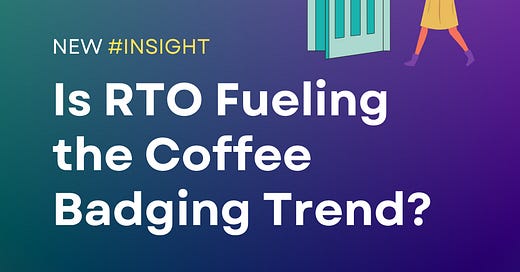As companies roll out return-to-office (RTO) mandates, a new phenomenon is brewing: coffee badging. Employees show up to the office just long enough to grab a coffee, and make it clear, “Hey, I was here.” Then, they vanish—sometimes to work from home, sometimes to head elsewhere entirely.
The question isn’t just why this is happening, but what it reveals about the disconnect between traditional office culture and the future of work. Let’s break it down.
What Exactly is Coffee Badging? 🤔
Think of it as the ultimate “seen and not heard” strategy. Coffee badging is the quiet rebellion against rigid RTO policies. Employees physically show up to satisfy attendance requirements but don’t stay long enough to do meaningful work or build the culture those RTO policies aim to restore.
It’s not just about compliance. Coffee badging says: I’ll meet you halfway, but the rest of the deal? That’s on my terms.
Why is Coffee Badging Trending Now?
Here’s the truth: RTO mandates are a tough sell. Many companies argue that collaboration, creativity, and culture require physical presence. But employees—especially Millennials (✌) and Gen Z—have experienced remote work’s flexibility and aren’t eager to give it up.
Here’s what’s fueling this trend:
The Culture of Presence: this “culture of presence” creates an environment where effort is rewarded over outcomes, leaving employees feeling misunderstood.
Hybrid Mismatches: some hybrid models mandate in-office days without considering whether employees’ work truly benefits from being in-person.
Unspoken Resistance: coffee badging is a quiet way of pushing back without outright breaking rules, often showing a lack of open communication.
What Does This Say About the Office? 🏢
If coffee badging is on the rise, it’s a sign the traditional office hasn’t adapted fast enough. RTO should create spaces employees want to go—not just feel obligated to show up at. But many offices fall short.
Here’s what’s not working:
Office Design: overbooked meeting rooms, cramped workstations, and poorly planned layouts make coming into the office a chore. If flex-office means fight for a desk, why bother?
Lack of Purpose: employees don’t just want a place to work; they want a reason to be there. If collaboration doesn’t feel organic or meaningful, the office becomes irrelevant.
Is Coffee Badging a Bad Thing? 👀
It depends on how you look at it. On one hand, it’s a sign employees value flexibility and autonomy. On the other, it highlights a disconnect between what leadership envisions and what employees actually need.
For companies, it’s a wake-up call. Employees want more than free coffee and an open-plan office. They want workplaces designed with intention, collaboration, and flexibility.
The Future: Offices People Want to Be In 🌟
To move past coffee badging, RTO needs a makeover. The office shouldn’t be a place you clock in and out of—it should be a destination for innovation, creativity, and connection.
Here’s what needs to happen:
Make It Worth the Commute: offer meaningful reasons to come in, like brainstorming sessions, mentoring, or high-impact collaboration days.
Listen to Employees: if they’re coffee badging, find out why. Is it the commute? The setup? The culture? Ask—and adapt.
Reimagine the Office: create spaces for both deep work and collaboration. Think modular layouts, reservable quiet zones, and a variety collaboration friendly meeting hubs.
Coffee badging isn’t just a quirky trend—it’s a mirror reflecting what’s not working in today’s office culture. RTO doesn’t have to be a mandate; it can be an invitation. But to get there, leaders need to think beyond attendance records.
If the office can’t deliver flexibility and policies that make sense, people will keep badging in—just for the coffee ☕️
Nermine Kay - NK Consulting 🇫🇷 / NKay Consulting LLC 🇺🇸
I'm Nermine Kay, a communication consultant specialized in the future of work!
Hit reply if you want to work with me on your communication strategy, LinkedIn branding and content creation!
🇫🇷 🇺🇸




